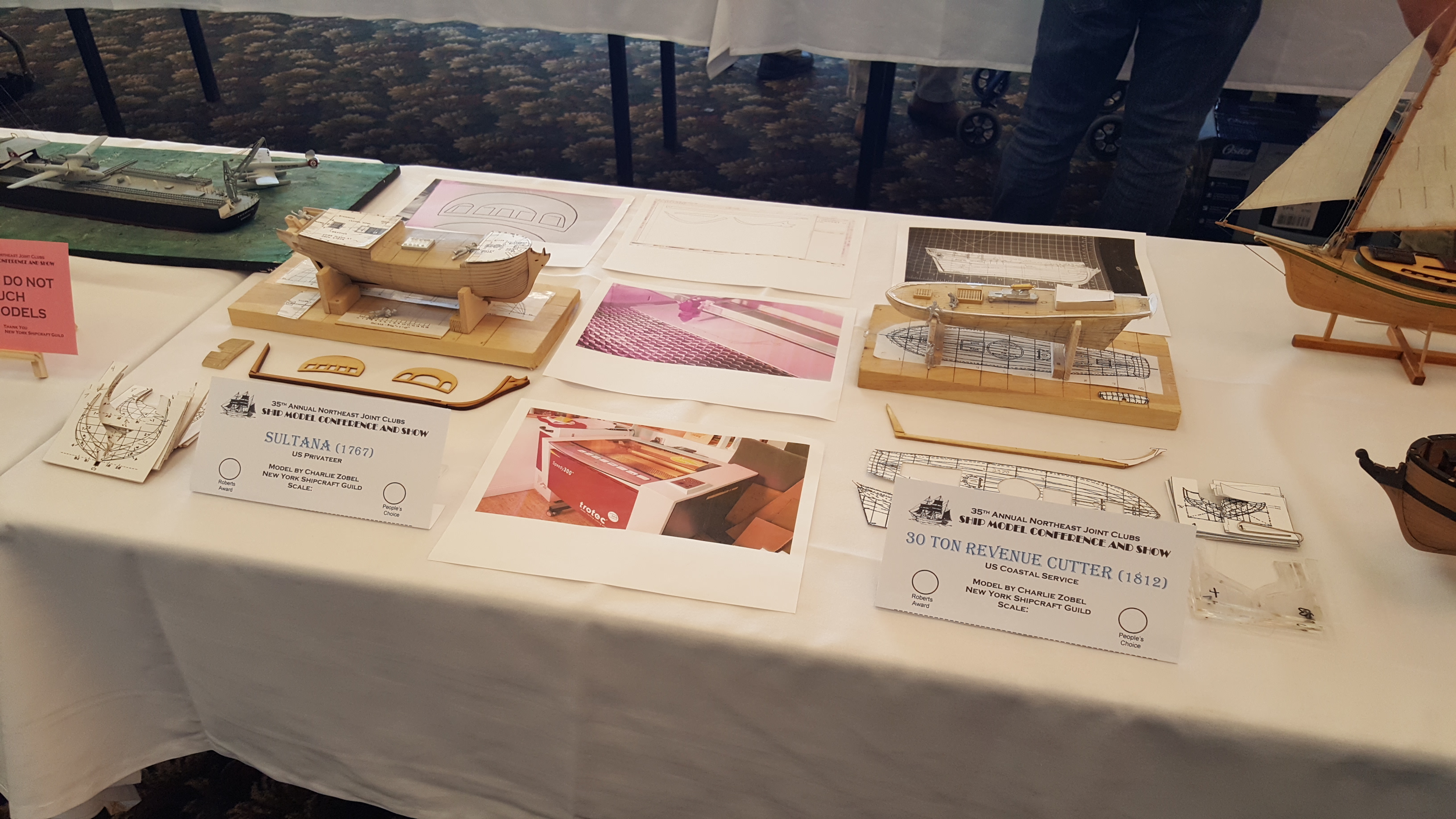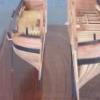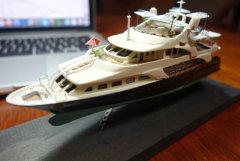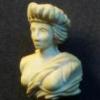MORE HANDBOOKS ARE ON THEIR WAY! We will let you know when they get here.
×
-
Posts
969 -
Joined
-
Last visited
Reputation Activity
-
 CharlieZardoz reacted to jbshan in 19th Century 31-ton Revenue Cutter by CharlieZardoz - Scale 1/64 - building as USRC Active based off Doughty plans and BlueJacket Shipcrafters kit
CharlieZardoz reacted to jbshan in 19th Century 31-ton Revenue Cutter by CharlieZardoz - Scale 1/64 - building as USRC Active based off Doughty plans and BlueJacket Shipcrafters kit
The holes in gratings should be maximum 3" square. This is so the crew's heels won't get caught as they traverse the gratings. Prototypically, the spacing might vary a bit to make the slats come out even, but keeping that maximum in mind at all times.
-
 CharlieZardoz reacted to shipmodel in 19th Century 31-ton Revenue Cutter by CharlieZardoz - Scale 1/64 - building as USRC Active based off Doughty plans and BlueJacket Shipcrafters kit
CharlieZardoz reacted to shipmodel in 19th Century 31-ton Revenue Cutter by CharlieZardoz - Scale 1/64 - building as USRC Active based off Doughty plans and BlueJacket Shipcrafters kit
Hi Charlie -
There are good descriptions and drawings of some carronades in both of the volumes of the NRG's Ship Modelers' Shop Notes, which I thought you had. There were a number of styles and shapes depending on the nation of origin and the year of manufacture, so you just have to pick the one that you think fits best with your ship. The article by Mark Lardas is a good start. He is a well known and respected ship modeler and author.
That said, the pivot mount for your guns is not very much like the slide mounts for broadside carronades. You can see the one I did for USS Oneida (1812) when you come to the meeting tonight. It was taken from Chapelle's description in History of the American Sailing Navy. I cannot locate the exact page at the moment.
Then there are scale drawings in three perspective views in any Anatomy of the Ship book which examines a ship that carried carronades. All drawings are labeled with numbered parts, so you can see that your 'hook' is actually a 'breaching ring' and your 'lump' is part of the sighting and aligning system.
Really looking forward to seeing how your laser cut parts come out.
Dan
-
 CharlieZardoz got a reaction from FriedClams in 19th Century 31-ton Revenue Cutter by CharlieZardoz - Scale 1/64 - building as USRC Active based off Doughty plans and BlueJacket Shipcrafters kit
CharlieZardoz got a reaction from FriedClams in 19th Century 31-ton Revenue Cutter by CharlieZardoz - Scale 1/64 - building as USRC Active based off Doughty plans and BlueJacket Shipcrafters kit
Well here is a new pattern, the front still square is only 4 by 4 now. This puts the galley stack closer to the center and looks a bit more in perspective to the larger grating in the back.
-
 CharlieZardoz got a reaction from shipmodel in 19th Century 31-ton Revenue Cutter by CharlieZardoz - Scale 1/64 - building as USRC Active based off Doughty plans and BlueJacket Shipcrafters kit
CharlieZardoz got a reaction from shipmodel in 19th Century 31-ton Revenue Cutter by CharlieZardoz - Scale 1/64 - building as USRC Active based off Doughty plans and BlueJacket Shipcrafters kit
Second is a more modified version the one is front is 5 by 5 holes and the one in back 8 by 8 holes. This one is similar in dimensions to various kits mamoli/krick/AL etc and honestly looks the best in my opinion. The other option would be to vary them up, last pic shows the one in front 4 by 5 and the 8 by 8 in the back. I'm open to opinions which do you all think looks best? Otherwise I'll probably pick option 3 with the mixed approach since to my eyes it just right. Also what about the size of the grating holes do they look to scale?
-
 CharlieZardoz got a reaction from dgbot in 19th Century 31-ton Revenue Cutter by CharlieZardoz - Scale 1/64 - building as USRC Active based off Doughty plans and BlueJacket Shipcrafters kit
CharlieZardoz got a reaction from dgbot in 19th Century 31-ton Revenue Cutter by CharlieZardoz - Scale 1/64 - building as USRC Active based off Doughty plans and BlueJacket Shipcrafters kit
Ok so thought Id show a bit of what ive been up to. Basically all these parts will be laser made. What I did in many instances was took the plans from Chapelle's book, the bluejacket kit and the Italian plan downloadable off the Internet and mixed and matched what parts work best. For example look at the 3 rudders the Alert is on the right so I chose that one then modified it to fit my keel. The cabin is a mix of all 3 the sides need to be rhombis shaped not a rectangle like in the italian plan (the follow the inclone of the deck). The carriage is from the Italian plan and the stern is from bluejacket but modified by the doughty plans. Once the laser renderings are finished, I will separate them to their various wood thicknesses. Also taking the scan of the deck to make the edging so it fits precisly.
-
 CharlieZardoz reacted to Mahuna in 19th Century 31-ton Revenue Cutter by CharlieZardoz - Scale 1/64 - building as USRC Active based off Doughty plans and BlueJacket Shipcrafters kit
CharlieZardoz reacted to Mahuna in 19th Century 31-ton Revenue Cutter by CharlieZardoz - Scale 1/64 - building as USRC Active based off Doughty plans and BlueJacket Shipcrafters kit
The holes in the gratings should be approximately 3 inches actual size. At 1:64 scale this is .05 inches.
-
 CharlieZardoz reacted to DocBlake in 19th Century 31-ton Revenue Cutter by CharlieZardoz - Scale 1/64 - building as USRC Active based off Doughty plans and BlueJacket Shipcrafters kit
CharlieZardoz reacted to DocBlake in 19th Century 31-ton Revenue Cutter by CharlieZardoz - Scale 1/64 - building as USRC Active based off Doughty plans and BlueJacket Shipcrafters kit
I prefer the 8X8 and 5X5, Charlie. The holes look good.
-
 CharlieZardoz got a reaction from Landlubber Mike in 19th Century 31-ton Revenue Cutter by CharlieZardoz - Scale 1/64 - building as USRC Active based off Doughty plans and BlueJacket Shipcrafters kit
CharlieZardoz got a reaction from Landlubber Mike in 19th Century 31-ton Revenue Cutter by CharlieZardoz - Scale 1/64 - building as USRC Active based off Doughty plans and BlueJacket Shipcrafters kit
Ok so thought Id show a bit of what ive been up to. Basically all these parts will be laser made. What I did in many instances was took the plans from Chapelle's book, the bluejacket kit and the Italian plan downloadable off the Internet and mixed and matched what parts work best. For example look at the 3 rudders the Alert is on the right so I chose that one then modified it to fit my keel. The cabin is a mix of all 3 the sides need to be rhombis shaped not a rectangle like in the italian plan (the follow the inclone of the deck). The carriage is from the Italian plan and the stern is from bluejacket but modified by the doughty plans. Once the laser renderings are finished, I will separate them to their various wood thicknesses. Also taking the scan of the deck to make the edging so it fits precisly.
-
 CharlieZardoz got a reaction from mtaylor in 19th Century 31-ton Revenue Cutter by CharlieZardoz - Scale 1/64 - building as USRC Active based off Doughty plans and BlueJacket Shipcrafters kit
CharlieZardoz got a reaction from mtaylor in 19th Century 31-ton Revenue Cutter by CharlieZardoz - Scale 1/64 - building as USRC Active based off Doughty plans and BlueJacket Shipcrafters kit
Second is a more modified version the one is front is 5 by 5 holes and the one in back 8 by 8 holes. This one is similar in dimensions to various kits mamoli/krick/AL etc and honestly looks the best in my opinion. The other option would be to vary them up, last pic shows the one in front 4 by 5 and the 8 by 8 in the back. I'm open to opinions which do you all think looks best? Otherwise I'll probably pick option 3 with the mixed approach since to my eyes it just right. Also what about the size of the grating holes do they look to scale?
-
 CharlieZardoz got a reaction from Eddie in What is the most EPIC kit available???
CharlieZardoz got a reaction from Eddie in What is the most EPIC kit available???
Also that HMS Warrior kit by Billing Boats like 60" looks pretty epic.
-
 CharlieZardoz got a reaction from J11 in The best copper plates?
CharlieZardoz got a reaction from J11 in The best copper plates?
Then Caldercraft has these which are supposedly 1/72 but at 6.5 by 17mm so sort of the same size as the other ones? But edge detail looks more to scale.
-
 CharlieZardoz got a reaction from Eddie in What is the most EPIC kit available???
CharlieZardoz got a reaction from Eddie in What is the most EPIC kit available???
I mean if by epic you mean covered in ornamentation cannons rigging and carvings then the answer is Sovereign of the Seas or Wasa. Both could probably cause a mental breakdown while building but what a way to go!
-
 CharlieZardoz reacted to DocBlake in Independence 1775 by DocBlake - Artesania Latina - 5/16" scale.
CharlieZardoz reacted to DocBlake in Independence 1775 by DocBlake - Artesania Latina - 5/16" scale.
I installed the moldings and the fascia to the transom. I still need to do some treenailing back there and install the taff rail, but the rail will come after the main rails are fitted to the bulwarks. The transom is jazzed up a bit, but still relatively simple for this small, converted merchantman. I think I like the look as it is and won't add any more to it.
-
 CharlieZardoz got a reaction from Larry Cowden in Independence 1775 by DocBlake - Artesania Latina - 5/16" scale.
CharlieZardoz got a reaction from Larry Cowden in Independence 1775 by DocBlake - Artesania Latina - 5/16" scale.
Hi Doc! Regarding quarter badges for the ship I would say yes she should have them or at least I would add them. Reason is 1 most ships at that time with a quarterdeck had them in the cabin and also the Halifax and similar type ships were all standard merchant schooners which were converted for battle so they all had that apple shape heavy design vs the other type of ship the Bermuda sloop or other sloops and galleys which would have probably lacked such a cabin space.
Aside from that regarding name there are a few options if you are looking for one. There were two Independence's active at the same time the 1776 Rhode Island sloop of 8 guns and the 1776 Massachusetts brigantine of 10 guns. Neither really fit a Halifax/Sultana style schooner however no measurements are on record so nothing against naming her Independence.
Hahn's colonial schooner book mentions a list of armed schooners employed at that time Hope, S Lawrence, Gaspey, Magdalen, Chaleur and St John. I imagine many of these looked like Chaleur or maybe Edward Hawke (the Marblehead schooner). Gaspee is depicted in Millar's book on the Continental Navy looking something similar to the schooner Baltick or Franklin. He also shows a few other schooners in that book of similar lines to your kit. Not exact but these are of course all conjecture. That said ive seen a version of Gaspee using either the kit or Halifax and it looked rather nice. Some pics below
-
 CharlieZardoz got a reaction from Canute in How much are you willing to pay
CharlieZardoz got a reaction from Canute in How much are you willing to pay
There is a post on here somewhere about buying a kit and replacing all the kit wood and metal with higher quality materials. My Sultana I invested probably 1000 already so its a very relative question.
-
 CharlieZardoz got a reaction from DocBlake in 19th Century 31-ton Revenue Cutter by CharlieZardoz - Scale 1/64 - building as USRC Active based off Doughty plans and BlueJacket Shipcrafters kit
CharlieZardoz got a reaction from DocBlake in 19th Century 31-ton Revenue Cutter by CharlieZardoz - Scale 1/64 - building as USRC Active based off Doughty plans and BlueJacket Shipcrafters kit
Ok so thought Id show a bit of what ive been up to. Basically all these parts will be laser made. What I did in many instances was took the plans from Chapelle's book, the bluejacket kit and the Italian plan downloadable off the Internet and mixed and matched what parts work best. For example look at the 3 rudders the Alert is on the right so I chose that one then modified it to fit my keel. The cabin is a mix of all 3 the sides need to be rhombis shaped not a rectangle like in the italian plan (the follow the inclone of the deck). The carriage is from the Italian plan and the stern is from bluejacket but modified by the doughty plans. Once the laser renderings are finished, I will separate them to their various wood thicknesses. Also taking the scan of the deck to make the edging so it fits precisly.
-
 CharlieZardoz got a reaction from FriedClams in 19th Century 31-ton Revenue Cutter by CharlieZardoz - Scale 1/64 - building as USRC Active based off Doughty plans and BlueJacket Shipcrafters kit
CharlieZardoz got a reaction from FriedClams in 19th Century 31-ton Revenue Cutter by CharlieZardoz - Scale 1/64 - building as USRC Active based off Doughty plans and BlueJacket Shipcrafters kit
Chapelle shows these ships with the -er "quoins" on his plan for the revenue cutters. So does the Mamoli and Krick models, but Corel ranger shows the screw design. Yet the Bluejacket kit has a different design for the truck (with wheels) and the corel doesn't have the "extended muzzle" while Krick and Alert does. Also Chapelle shows Fair Rosamond with a pin/screw design dated 1833 and caldercraft has the pin design for it's hms Pickle and hms Ballahoo of 1802... so the bottom line is I'm quite confused. Not in what you are saying jbshan but in how these kits are all over the map with armament. All I really need to know is when was the pin/screw invented at least then I will know if it was in service by 1818-1825. Guess some research is in order.
-
 CharlieZardoz reacted to Chuck in How much are you willing to pay
CharlieZardoz reacted to Chuck in How much are you willing to pay
Its really not a fair question. It depends on what you will be satisfied with in the end result. The old motto is true...."you get what you pay for".
You can spend 5 bucks for a chisel or you can spend $150 for a better one. My guess is you will not be happy with the $5 chisel and will end up throwing it away. You can spend $30 for a bandsaw blade or $225. Etc. Etc....
You get what you pay for. This hobby is certainly not going to allow you to build models like this one below for $200 - $300. Its an expensive hobby once it grabs hold of you. It just depends on what you will be satisfied with in the end. Again its not really a fair question because some folks are willing to invest much money (if they can) and much time tobuild a model like this....but many are just as satisfied with a less ambitious result.
If you are going to spend $1000 bucks on something that will take you maybe three years to complete I would say that is a very reasonable and inexpensive hobby. How many people spend just $335 dollars a year on a hobby for decent results. Especially if its something that will give you years of pleasure and enjoyment. I know guys that drop 100's every month bowling on a league......for me its just not worth it. I think that kind of money is better spent on ship modeling is.....so again....its not really a fair question. It more about how much do you really want it. You spend money on what you are passionate about and everyone is different.....I spent 200 dollars on a cheap saw once because I couldnt afford a good one. It was a terrible decision. Finally I saved enough to buy a Byrnes saw and it makes the hobby much more enjoyable. And that saw will last me a lifetime while the cheaper one was good for nothing out of the box.
-
 CharlieZardoz reacted to wefalck in SMS WESPE 1876 by wefalck – FINISHED - 1/160 scale - Armored Gunboat of the Imperial German Navy - as first commissioned
CharlieZardoz reacted to wefalck in SMS WESPE 1876 by wefalck – FINISHED - 1/160 scale - Armored Gunboat of the Imperial German Navy - as first commissioned
S.M.S. WESPE (HENK, 1895)
History and context
The WESPE-Class armoured gun-boats of the then young Imperial German Navy were born out of a tactical concept that dated well back into the Napoleonic era. The idea was to mount a heavy long-range gun onto a highly mobile small craft that would be able to retire into shallow coastal waters, beyond the range of even the heavy artillery of an attacking fleet. The addition of a steam engine and the increase in calibre followed the development of the time, of course. Adding heavy armour to the front (mainly) was meant to give the gun-boats a certain attacking capability. It also owes something to the floating batteries used in the defence of Copenhagen during the Napoleonic wars and to the armoured floating batteries used by the allied French/British forces during the Crimean War (1854-55). In fact, adding armour plating to a (rowing) gunboat was already proposed as early as the late 18th century in Spain, as documented by a model in the Museo Naval in Madrid, but apparently never put to work in full scale.
S.M.S. WESPE, brand-new and still without the 30.5 cm gun (1875)
At the time of the conception of the WESPE-class in the early 1870s a former cavalry(!) general was the naval chief-of-staff in Germany. The tactical dogma was ‘proactive defence’: an attacking enemy was to be awaited near home waters and fenced off. The main threat was seen in amphibian operations attacking the German coast. Thus, the landing of troops at strategic points had to be prevented. Long-range strategic and oceanic operations were out of the scope of the German naval planners of the time. There was a certain logic in this, as Germany, unlike Britain, is/was a more or less land-locked country and largely self-sufficient in many respects at that time. Overseas trade then did not have such an importance as in Britain or as in later globalising economies. Therefore, attempts to severe overseas supply chains was not so relevant. There was, indeed, active resistance from trade interest groups, particularly the merchants in the cities of Hamburg and Bremen, to a navy that would engage itself overseas. These merchants relied on their network of friendly contacts and on sailing under a neutral flag.
Hence, the WESPE-Class was designed to be mainly a heavily armoured gun-platform, giving long-range protection to the tidal North Sea harbours that are surrounded by mud-flats and to give mobile protection to the deep fjords of Schleswig-Holstein's Baltic coast. They would be backed-up by heavy artillery (and later fixed torpedo batteries) in coastal forts.
The guns in such boats usually could only be trained by turning the whole boat. This seems more difficult then it probably was, because even in the old days of the rowing gunboats they would attack by rowing in a wide circle and when the intended target passed through the line of aim, one would fire. As the WESPE-Class was designed to let themselves fall dry on mud-flats, a possibility to train the gun itself was needed.
This distinguished the WESPE-class from earlier boats of similar design in Britain, namely the ANT-, GADFLY-, and BOUNCER-class of the 1860s. Man other navies took up the same concept and there were examples in the Danish, Dutch, French, Norwegian, Spanish, and even the Argentinian navy. Some of the were armoured, while other were still constructed from wood or composite.
S.M.S. WESPE under construction (HENK, 1895)
Technical Description
The WESPE-class comprised ten boats delivered in two batches between 1876 and 1880: WESPE (1876), VIPER, BIENE, MÜCKE, SCORPION, BASILISK, CAMAELEON, CROCODILL, SALAMANDER and NATTER. They were all built by A.G. Weser in Bremen. With a length of 46.4 m and a beam of 10.65 m they had a dead weight of 1157 t, drawing 3.37 m. The dimensions vary somewhat according to source, but this may be due to different reference points, such as length overall compared to length between the perpendicles etc.
Two inclined double-expansion engines on two propellers gave a maximum speed of 11 knots. Their original complement was 3 officers and 73 crew. Steering was from a stand on the hut and an emergency double steering wheel abaft. Very early on they were also retrofitted with an electrical generator.
The WESPE-class were the first German warships (and indeed among the first of any warship) that did completely without auxiliary sails. As the consequence they only had a light mast for signalling. In spite of sporting quite some leading edge technology, they were only of limited seaworthiness and their handling was far from perfect. This resulted in them being given a collection of rather unfavourable nicknames. They were also not very popular with their crews and officers due to the cramped conditions below decks, but then they were not meant for long voyages in the open sea.
Admiralty illustrative drawing (before 1883)
Armament
The main armament was a single 30.5 cm rifled breech-loading gun designed and manufactured by Alfred Krupp AG in Essen. At the time the WESPE-class boats were designed, fast torpedo-boats did not exist yet – the automotive fish-torpedo was just being developed. When in the mid-1880s small torpedo-boats became a tactical reality, some form of self-defence against them was necessary and two bronce(!) 8.7 cm/l24 breech-loading guns in ‘disappearing’ carriage and two 37 mm Hotchkiss revolving guns came on board. In fact, very early on (1883) also two 35 cm underwater torpedo launching tubes were installed to increase the attacking capabilities.
Instruction model for the Rk 30.5/l22 on the Danish HELGOLAND in the Orlogsmuseet Copenhagen on a carriage similar to that of the WESPE-Class
Scale
The scale chosen for the model is 1/160, which admittedly is somewhat unusual for a ship model. However, the reasoning behind this choice was that a large selection of N-scale railway figures is available that eventually will crew the ship. There are also space and portability consideration, which are important for someone, who has to move from time to time for professional reasons.
The model will be a waterline model. This will allow a scenic presentation of the finished model. Besides, the hull below the waterline is not quite so graceful. Above the waterline the hull is also more or less prismatic, with vertical bulwarks and virtually no sheer. These parameters together call for a bread-and-butter construction.
Artist’s impression of a WESPE-Class gunboat (1891)
Sources
Owing to the loss of most of the archival material from the former Admiralty Drawing Office during and after the end of WW2, detailed source material is rather scant. Some lithographed drawings that must have been made before the major refit in 1883 have survived and serve as a basis for the reconstruction. The Bundesarchiv/Militärarchiv in Freiburg i.B. has some drawings, but unfortunatelly they only pertain to a much later refit of S.M.S. NATTER. However, the WESPE-Class was a bit of a novelty at its time and some Detaildrawings of bothm the ship and the armament, have found their way into textbooks of the time. Relatively recently a very detailed original drawing of the gun became available on the Internet from a private collection (www.dreadnoughtproject.org). Historic photographs from the early days of the ships are quite rare and mostly of not so good quality, but some reasonably good ones from the end of their active life have survived.
Based on the information that was available in the 1980s Wolfgang Bohlayer drew and published a plan of S.M.S. WESPE as she might have looked like after the major refit in 1883 (available from VTH, http://shop.vth.de/wespe-1876.html). Based on the information available today, this plan would need to be revised in some details.
The available information is summarised on the page on the WESPE-class on my Web-site: http://www.wefalck.eu/mm/maritime/models/wespe/wespeclass.html
To be continued ...
-
 CharlieZardoz got a reaction from FriedClams in 19th Century 31-ton Revenue Cutter by CharlieZardoz - Scale 1/64 - building as USRC Active based off Doughty plans and BlueJacket Shipcrafters kit
CharlieZardoz got a reaction from FriedClams in 19th Century 31-ton Revenue Cutter by CharlieZardoz - Scale 1/64 - building as USRC Active based off Doughty plans and BlueJacket Shipcrafters kit
Ok so thought Id show a bit of what ive been up to. Basically all these parts will be laser made. What I did in many instances was took the plans from Chapelle's book, the bluejacket kit and the Italian plan downloadable off the Internet and mixed and matched what parts work best. For example look at the 3 rudders the Alert is on the right so I chose that one then modified it to fit my keel. The cabin is a mix of all 3 the sides need to be rhombis shaped not a rectangle like in the italian plan (the follow the inclone of the deck). The carriage is from the Italian plan and the stern is from bluejacket but modified by the doughty plans. Once the laser renderings are finished, I will separate them to their various wood thicknesses. Also taking the scan of the deck to make the edging so it fits precisly.
-
 CharlieZardoz got a reaction from Omega1234 in 19th Century 31-ton Revenue Cutter by CharlieZardoz - Scale 1/64 - building as USRC Active based off Doughty plans and BlueJacket Shipcrafters kit
CharlieZardoz got a reaction from Omega1234 in 19th Century 31-ton Revenue Cutter by CharlieZardoz - Scale 1/64 - building as USRC Active based off Doughty plans and BlueJacket Shipcrafters kit
Ok so thought Id show a bit of what ive been up to. Basically all these parts will be laser made. What I did in many instances was took the plans from Chapelle's book, the bluejacket kit and the Italian plan downloadable off the Internet and mixed and matched what parts work best. For example look at the 3 rudders the Alert is on the right so I chose that one then modified it to fit my keel. The cabin is a mix of all 3 the sides need to be rhombis shaped not a rectangle like in the italian plan (the follow the inclone of the deck). The carriage is from the Italian plan and the stern is from bluejacket but modified by the doughty plans. Once the laser renderings are finished, I will separate them to their various wood thicknesses. Also taking the scan of the deck to make the edging so it fits precisly.
-
 CharlieZardoz got a reaction from mtaylor in 19th Century 31-ton Revenue Cutter by CharlieZardoz - Scale 1/64 - building as USRC Active based off Doughty plans and BlueJacket Shipcrafters kit
CharlieZardoz got a reaction from mtaylor in 19th Century 31-ton Revenue Cutter by CharlieZardoz - Scale 1/64 - building as USRC Active based off Doughty plans and BlueJacket Shipcrafters kit
Ok so thought Id show a bit of what ive been up to. Basically all these parts will be laser made. What I did in many instances was took the plans from Chapelle's book, the bluejacket kit and the Italian plan downloadable off the Internet and mixed and matched what parts work best. For example look at the 3 rudders the Alert is on the right so I chose that one then modified it to fit my keel. The cabin is a mix of all 3 the sides need to be rhombis shaped not a rectangle like in the italian plan (the follow the inclone of the deck). The carriage is from the Italian plan and the stern is from bluejacket but modified by the doughty plans. Once the laser renderings are finished, I will separate them to their various wood thicknesses. Also taking the scan of the deck to make the edging so it fits precisly.
-
 CharlieZardoz reacted to Cathead in USRC Ranger 1819 by Cathead – FINISHED – Corel – Scale 1:64
CharlieZardoz reacted to Cathead in USRC Ranger 1819 by Cathead – FINISHED – Corel – Scale 1:64
I've spent much of the last week experimenting with sail design, finishing a topsail last night that I'm pretty happy with:
I posted details about the design approach to this sail over on this thread on realistic sail-making, so won't duplicate that content here. Quick version, the out-of-scale boltropes are intentional, choosing function and an artistic look over strict accuracy. The sail is made of bond paper, with individual panels following real sail-making practice. What do you all think?
I've also slowly moved forward on rigging. I started with the bowsprit assembly, since it's an isolated area that I can complete while getting my head around certain skills and methods. Now I need to move forward on the regular rigging, and have been studying the plans and other references obsessively to try and assemble a sensible plan that will minimize the need to reach around rigging to do other rigging. Certainly one first step is to make the rest of the sails and bend them to their respective booms/yards.
I find rigging both fascinating and infuriating, so this should be an interesting time coming up. Of course, I have lots of time this weekend as we're under threat of an ice storm here in Missouri, so I won't be distracted by outdoor activities. On the other hand, if the power goes out, I may be working on this by candlelight just like the old-timers. What could go wrong?
-
 CharlieZardoz got a reaction from archjofo in 19th Century 31-ton Revenue Cutter by CharlieZardoz - Scale 1/64 - building as USRC Active based off Doughty plans and BlueJacket Shipcrafters kit
CharlieZardoz got a reaction from archjofo in 19th Century 31-ton Revenue Cutter by CharlieZardoz - Scale 1/64 - building as USRC Active based off Doughty plans and BlueJacket Shipcrafters kit
Check out my babies all lined up together now, making quite a fleet even if they all need planking lol.
-
 CharlieZardoz got a reaction from Omega1234 in 19th Century 31-ton Revenue Cutter by CharlieZardoz - Scale 1/64 - building as USRC Active based off Doughty plans and BlueJacket Shipcrafters kit
CharlieZardoz got a reaction from Omega1234 in 19th Century 31-ton Revenue Cutter by CharlieZardoz - Scale 1/64 - building as USRC Active based off Doughty plans and BlueJacket Shipcrafters kit
The photo is sufficient for me to understand how the pin/screw is supposed to connect to the carriage. Thank you so much this will give me what I need to complete the carronade












